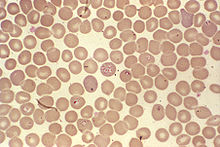Babesiosis causes
Editor-In-Chief: C. Michael Gibson, M.S., M.D. [1]Associate Editor(s)-in-Chief: Ilan Dock, B.S.
Overview
Babesiosis is caused by apicomplexan parasitic organism within the genus Babesia. B. Microti and B. divergens are the two species of Babesia that have been frequently reported as parasitic within human populations. Babesia parasites reproduce in red blood cells, where they can be seen as cross-shaped inclusions (4 merozoites asexually budding but attached together forming a structure looking like a "Maltese Cross") and cause hemolytic anemia, quite similar to malaria.
Organism
- The genus babesiidae hosts over 100 species of Babesia. However, Babesia Microti (B.Microti) and Babesia Divergens (B. Divergens) are most frequently reported as the apicomplexan parasitic organisms responsible for causing human infections (Babesiosis.)
- Babesia are transmitted through a Tick vector, most notably the Ixodidae tick family.
Etymology and pronunciation
- Babesia was named after Victor Babes, the physician and scientist who originally discovered the parasite as the primary culprit in the hemolytic illness, Babesiosis.
Taxonomy
| Kingdom | Eukaryota |
|---|---|
| Phylum | Alveolata |
| Class | Apicomplexa |
| Order | Aconoidasida |
| Family | Piroplasmida |
| Genus | Babesiidae |
| Two species most frequently reported as pathogenic within Human populations | Babesia Microti (B.Microti) and Babesia Divergens (B. Divergens) |
Human pathogen
- Human pathogenic species are most frequently reported as B. Microti and B. Divergens.
- Babesia parasites reproduce in red blood cells, where they can be seen as cross-shaped inclusions (4 merozoites asexually budding but attached together forming a structure looking like a "Maltese Cross") and cause hemolytic anemia, quite similar to malaria.
- Infection as a result of B. Microti can result in either an asymptomatic infection or a number of malaria-like symptoms. Infection may be fatal and those who are immunocompromised or have undergone a splenectomy are at an increased risk of death. The incubation of B. Microti is between 1-8 weeks, after which malaria-like symptoms will appear. Parasitemia levels may rise percentages in the high 80's, yielding fatal results. However high level of parasitemia are most often correlated to immunocompromised or splenectomized patients.
- Infection as a result of B. Divergens is often associated with a higher rate of fatality. Incubation periods for B. Divergens are less than those of B. Microti at an average of 1-4 weeks. Symptoms also differ with severe complications such as shock-like symptoms.
- Babesiosis, the disease attributed to Babesia infection is a tick-borne illness. Thus transmission occurs as a result of a tick bite and a higher rate of transmission is associated with longer blood meal periods.
- Transmission may also occur in as a result of blood transfusion from blood collected in an endemic area.
Gallery

References
- ↑ Babesia. General Information. Stanford University. http://web.stanford.edu/group/parasites/ParaSites2009/NaikhobaManobi_Babesia/NaikhobaManobi_Babesia.html Accessed on December 08, 2015
- ↑ Babesia. Taxonomy of Babesia Divergens. http://www.metalife.com/NCBI%20Taxonomy/32595
- ↑ General Information. Centers for Disease Control and Prevention (2015). http://www.cdc.gov/parasites/babesiosis/gen_info/index.html Accessed on December 08, 2015
- ↑ 4.0 4.1 Babesiosis For Health Professionals. European Centers for Disease Control and Prevention (2015). http://ecdc.europa.eu/en/healthtopics/babesiosis/Pages/Factsheet_health_professionals.aspx Accessed on December 08, 2015
- ↑ Babesiosis. For Health Professionals. Centers for Disease Control and Prevention (2015). http://www.cdc.gov/parasites/babesiosis/health_professionals/index.html Accessed on December 08, 2015